Homemade vegetable chow mein that's better than takeout and almost as easy! With crispy noodles, stir-fried veggies and savory sauce, there's lots to love about this vegan version of a Chinese classic.

Call me silly, but I'm a big fan of cooking lucky New Year's dishes around the start of the year. Am I the only one who does this? Do you guys even know this is a thing?
Certain dishes are supposed to bring good stuff in the New Year. For example, beans and greens are supposed to bring for money (beans represent coins, greens represent dollars), which is why hoppin' John is traditionally served around the holiday. Long noodles are foretold to bring forth longevity.
Not that I'm superstitious. It's all in good fun!
This year I decided to perfect my vegetable chow mein recipe in preparation for the big day. I'm not sure if this one will bring me luck, but it's certainly delicious!
Jump to:
Chow Mein vs. Lo Mein
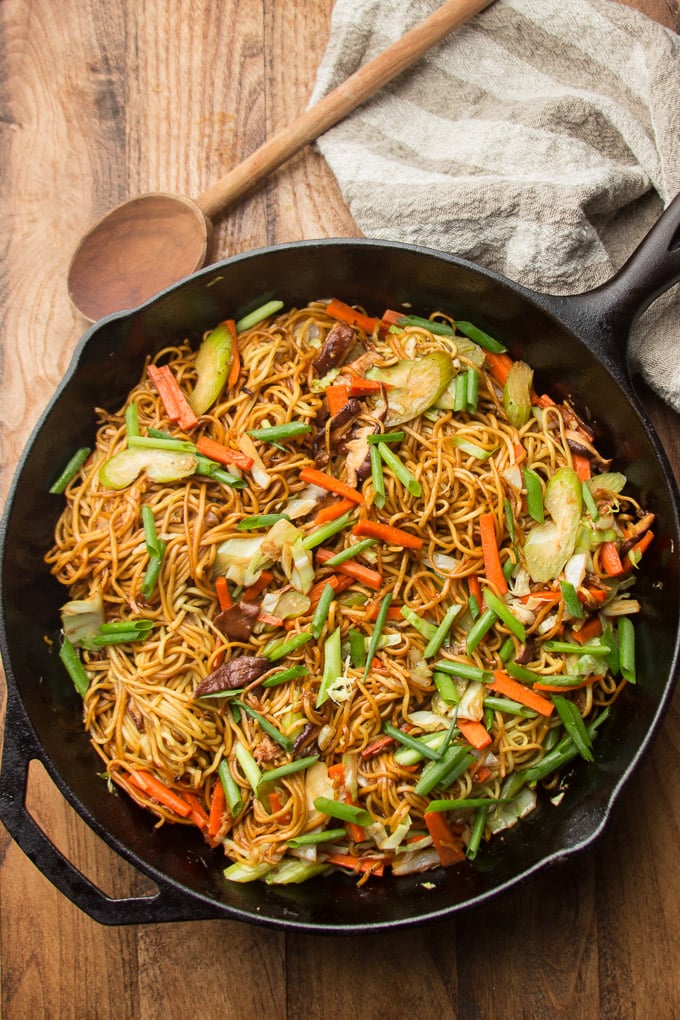
We've had an ongoing debate/discussion that comes in my family every time we go out for Chinese food. What's the difference between chow mein and lo mein?
I guess it makes sense that there's some confusion, because they're pretty similar. Both dishes are made with noodles, stir-fried veggies, and soy-based sauce. The difference is in the noodles.
- Chow mein noodles are a thinner than lo mein noodles.
- Chow mein noodles undergo a bit of extra frying to get them super crispy. Whereas with lo mein the noodles get thrown into the pan towards the end of cooking and stir-fried for a just a bit, with chow mein the noodles get fried first in a couple of tablespoons of oil, until they're nice and crispy.
Ingredients You'll Need

Noodles
We're using dried chow mein noodles for this recipe, because in my experience the fresh ones usually contain egg. You can buy dried vegan chow mein noodles at most supermarkets, or online.
If you can't find chow mein noodles, try substituting ramen noodles, which are very similar. What's really important is the thickness — you want your noodles to be on the thinner side so they crisp up easily when you fry them.
Sauce
Our vegan chow mein sauce is a simple mixture of soy sauce, dark mushroom soy sauce, hoisin sauce, brown sugar, cornstarch, and sesame oil. Just about all of these ingredients are available at the supermarket, except maybe the dark mushroom soy sauce, which you can buy online or in an Asian market.
If you can't get your hands on the mushroom soy sauce, substitute additional regular soy sauce — you might just need a splash extra (dark mushroom soy sauce is more intense than regular), which you can add at the end of cooking when you taste-test the noodles.
Veggies
Scallions (a.k.a. green onions), garlic, and ginger are our aromatics and will be adding some extra flavor to the chow mein.
Shiitake mushrooms, carrots, celery and cabbage are our stir-fry veggies. We're making a mixed vegetable chow mein here, so I've included lots of variety! Feel free to substitute with your favorites or whatever you have on hand, keeping in mind that harder veggies can be added to the skillet earlier, and softer ones later.
How to Make Vegetable Chow Mein
The following is a detailed photo tutorial on how to make this dish. Scroll all the way down if you'd like to skip right to the recipe!
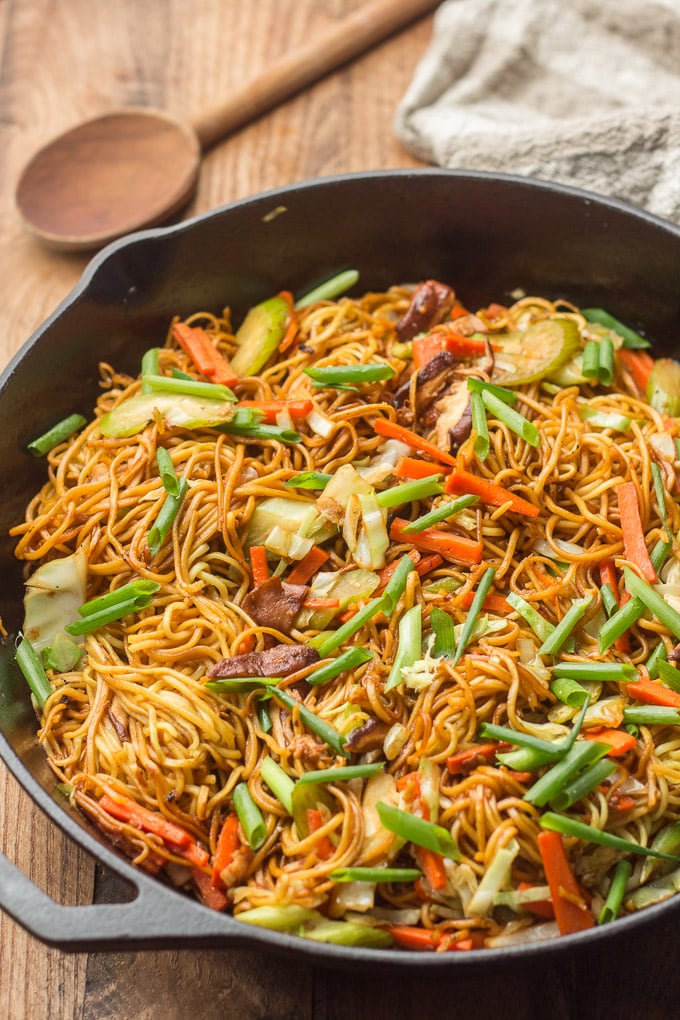
Start by prepping everything. Mix your sauce, chop the veggies, and boil the noodles. The stir-frying process goes fast, so you want everything to be ready for you when you need it.
Heat some oil in a wok or skillet. Tip: use a cooking vessel with a good nonstick surface. A wok would be ideal, but I went with my cast-iron skillet for the cooking surface.
Once the oil is hot, add your cooked noodles. Let them fry in the oil for a couple of minutes, then take a fork or a spatula and redistribute the noodles in the skillet. Keep doing this, giving the noodles a few minutes to fry each time, until you've got lots of browned and crispy spots.
Now remove the noodles from the skillet and transfer them to a plate.
Add a bit more oil to the skillet, let it heat up, and then add your mushrooms. Cook them for just a few minutes, until they start to soften up and brown in spots.
Next, push the mushrooms to the side and add the white parts of your scallions, along with the garlic and ginger. Cook them for just a minute, being careful to avoid burning.
Crank up the heat and get ready to stir-fry. Carrots and celery go in at this point. Use a spatula to keep them moving. After about 2 minutes they should begin to brighten in color.
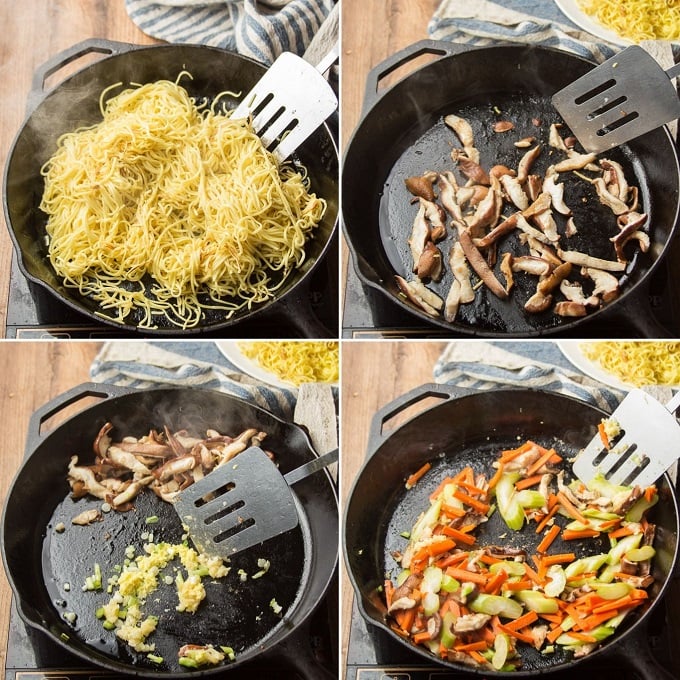
Now add the cabbage. Stir-fry everything for about 1 minute more before adding the sauce and noodles.
Use a fork or spatula to distribute the ingredients, making sure the sauce evenly coats the noodles.
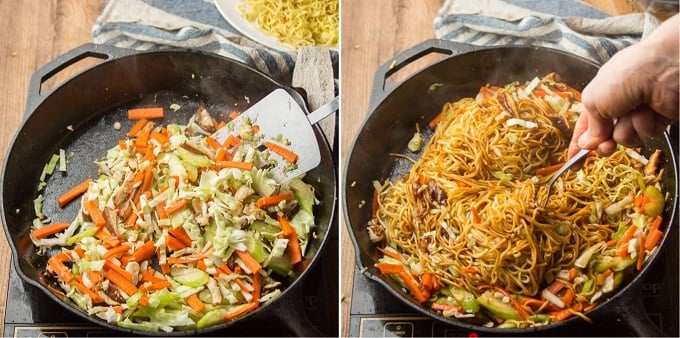
Take the skillet off of the heat and add the green parts of your scallions.
Serve your chow mein right away, while it's hot and the noodles are crispy!
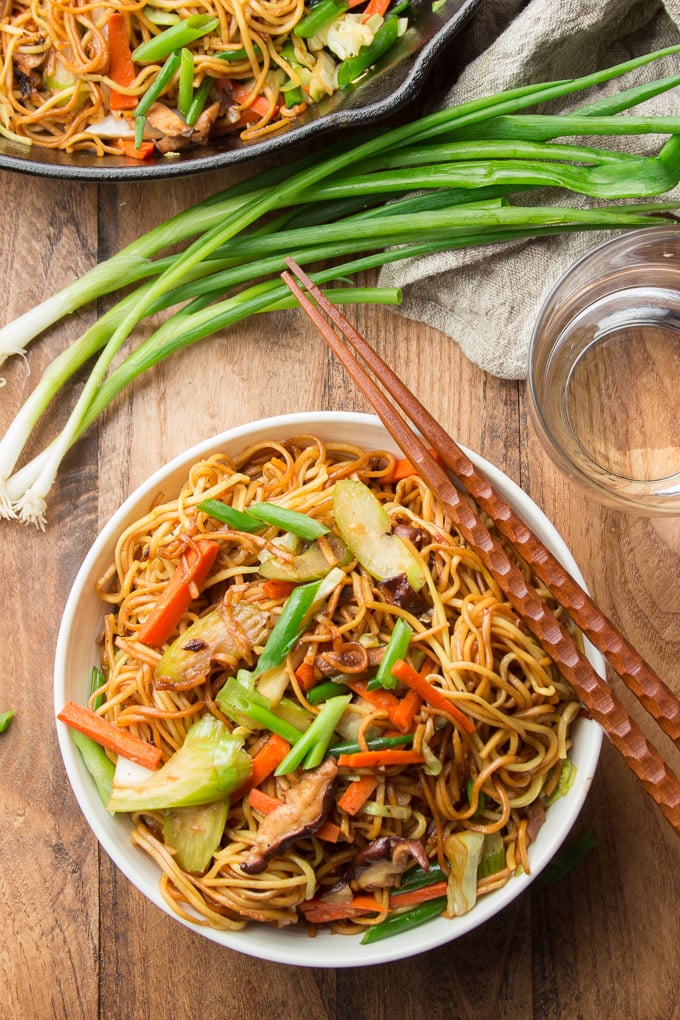
Leftovers & Storage
Leftover veggie chow mein will keep in a sealed container in the fridge for up to 3 days.
Pro Tips
- Prep everything before you start cooking and have it ready to go. Once you begin the process of stir-frying you won't have time to do any additional prep work.
- Want to add some protein to your chow mein? Pan-fry some tofu according to this method and add it at the end of cooking.
- Feel free to switch up the veggies with your favorites. Broccoli, snow peas, and bell peppers would all be delicious in this dish. Keep in mind that harder veggies cook slower, so add them first, while softer veggies cook faster, so add them last.
More Asian Noodle Recipes
Like this recipe? If so, be sure to follow me on Facebook, Pinterest or Instagram, or subscribe to my newsletter. And please stop back and leave me a review and rating below if you make it!
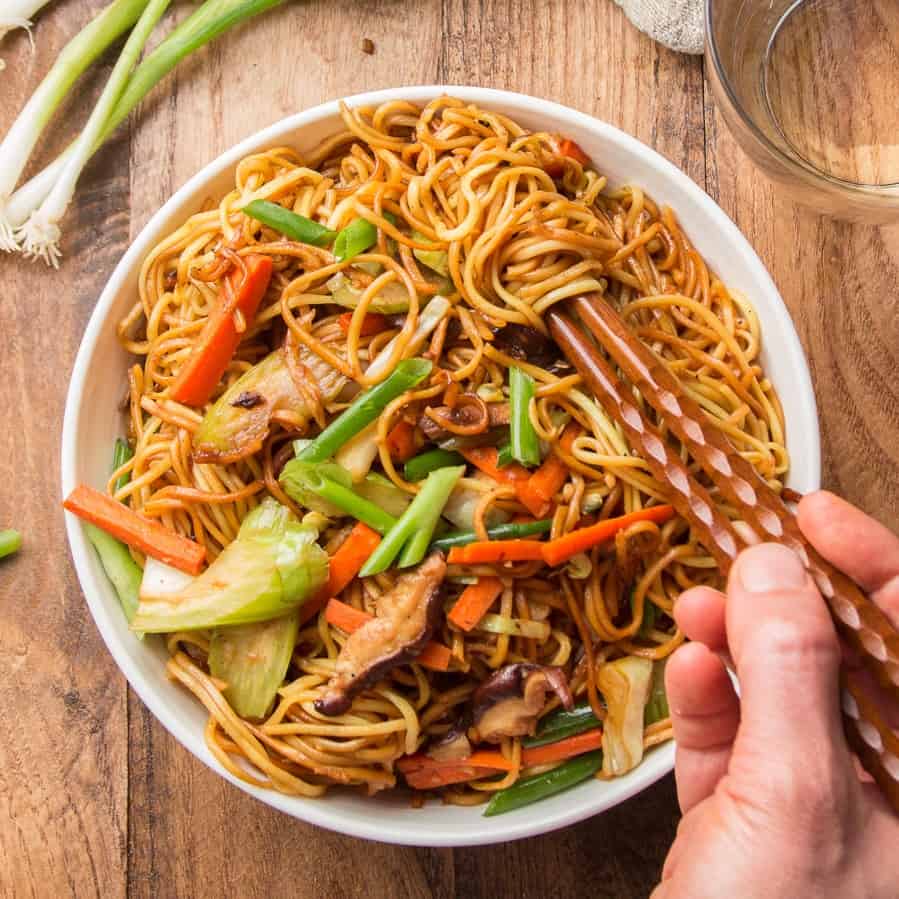
Vegetable Chow Mein
Homemade vegetable chow mein that's better than takeout and almost as easy! With crispy noodles, stir-fried veggies and savory sauce, there's lots to love about this vegan version of a Chinese classic.
Ingredients
- 8 ounces dried chow mein noodles (you can substitute with ramen noodles if needed)
- 2 tablespoons soy sauce
- 1 tablespoon dark mushroom soy sauce
- 1 tablespoon hoisin sauce
- 2 teaspoons organic brown sugar
- 2 teaspoons cornstarch
- 1 teaspoon toasted sesame oil
- 4 tablespoons peanut oil, or high heat oil of choice, divided
- 6 ounces shiitake mushrooms, stems removed, cleaned, and sliced
- 4 scallions, white and green parts separated, white parts finely chopped, green parts cut into 1-inch lengths
- 4 garlic cloves, minced
- 2 tablespoons freshly grated ginger
- 1 cup julienne cut carrots (about 2 medium carrots)
- 1 cup chopped celery (about 2 medium stalks)
- 1 ½ cups sliced cabbage
Instructions
-
Bring a large pot of water to a boil.
-
Add the noodles and cook them according to the package directions.
-
Drain the noodles into a colander, rinse them with cold water, and then return them to the pot. Toss the noodles with a dash of oil to prevent sticking.
-
Whisk the soy sauce, mushroom soy sauce, hoisin sauce, brown sugar, cornstarch, and sesame oil together in a small bowl, making sure to dissolve the sugar.
-
Place a large skillet or wok with a nonstick surface over medium heat. Add 3 tablespoons of oil to the skillet.
-
Give the oil a few minutes to heat up, and then add the noodles, arranging them in a relatively even layer.
-
Fry the noodles in the oil for about 2 minutes until they begin to crisp on the bottom, then use a fork or spatula to redistribute the noodles. Continue cooking and redistributing the noodles every 2 minutes or so, until they have lots of crispy spots. This should take a total of about 8 minutes.
-
Remove the noodles from the skillet and transfer them to a plate.
-
Add the remaining tablespoon of oil to the skillet. Give it a minute to heat up, then add the mushrooms.
-
Let the mushrooms cook for about 4 minutes, until they begin to soften up and brown on the bottoms.
-
Push the mushrooms to the side and add the garlic, ginger, and white parts of scallions to the skillet. Cook the aromatics for about 1 minute, until very fragrant, being careful to avoid burning.
-
Raise the heat to high and add the carrots and celery to the skillet. Stir-fry the veggies until they brighten in color slightly, about 2 minutes.
-
Add the cabbage and continue to stir-fry for about 1 minute, until it just begins to soften.
-
Return the noodles to the skillet and add the soy sauce mixture. Use a fork or spatula to distribute the ingredients, making sure to get an even coating of the sauce on the noodles.
-
Remove the skillet from the heat and stir in the green parts of the scallions.
-
Divide onto plates and serve.


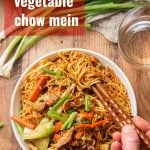
what type of gluten free needles would you recommend?
I haven't tried this with any gluten-free noodles, but I'm thinking a gluten-free cappellini like this one might work: https://www.vitacost.com/jovial-organic-brown-rice-pasta-gluten-free-capellini
Great recipe. It came out perfectly!
Absolutely amazing. i strayed fairly far from the original recipe (not using hoisin, only using regular soy, changing the seasonings, frying differently) but they came out better than great. The spaghetti i used became chewier than udon, and super thick. The noodles were filled with flavor and it was such a fun dish to eat. I usually adore "better than changs" lo mein and make lo mein almost every day, but this recipe has replaced that.
What brand of dark mushroom soy sauce and hoisin sauce do you reccomend. I am going to get my things to make this it sounds delish!